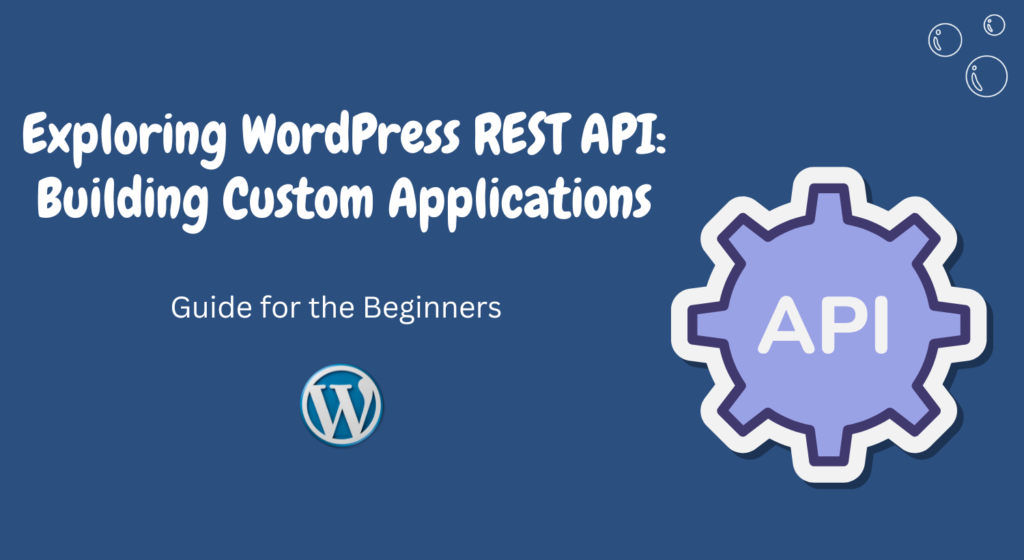In today’s rapidly evolving digital landscape, WordPress continues to be the go-to platform for creating websites.
Its user-friendly interface and vast plugin ecosystem make it an attractive choice.
However, to truly harness the full potential of WordPress, developers often need to extend its capabilities and build custom applications.
This is where the WordPress REST API comes into play. In this comprehensive article, we’ll delve deep into the WordPress REST API and explore how it empowers developers to build highly customized web applications seamlessly.
Understanding the WordPress REST API
What is the WordPress REST API?
The WordPress REST API, or Application Programming Interface, is a set of rules and protocols that facilitate communication between different software applications.
Essentially, it serves as a bridge, allowing data to flow between your WordPress website and other applications, services, or platforms.
This interaction occurs over HTTP, making it accessible and versatile.
The Evolution of WordPress APIs
To grasp the significance of the WordPress REST API, it’s essential to understand its evolution.
Historically, WordPress employed XML-RPC and SOAP APIs for remote communication.
However, these protocols had limitations, were often inefficient, and posed security risks.
With the REST API, WordPress adopted a more modern, efficient, and secure approach to data interaction, aligning itself with contemporary web development practices.
Building Blocks of the WordPress REST API
Endpoints and Routes
Endpoints are specific URLs within your WordPress site that serve as entry points for retrieving or manipulating data. Routes, on the other hand, define the structure and behavior of these URLs.
Understanding how to create custom endpoints and routes is a fundamental skill for developers looking to craft tailored applications.
Authentication Methods
Security is paramount when working with APIs.
The WordPress REST API offers multiple authentication methods, including OAuth 2.0 and API keys.
Familiarizing yourself with these authentication mechanisms is crucial to ensure that your custom applications are safeguarded from unauthorized access.
Leveraging the WordPress REST API in Custom Applications
Creating a Custom Plugin
One of the most common ways to utilize the REST API is by developing custom plugins.
These plugins can interact with the API, extending your website’s functionality in unique ways.
We’ll provide a step-by-step guide on creating a plugin that leverages the API, enabling you to tailor your WordPress site to your specific needs.
Building a Mobile App
In an era where mobile usage is ubiquitous, knowing how to build a mobile application that integrates seamlessly with your WordPress site is invaluable.
Whether you’re developing for iOS, Android, or both, the REST API provides a unified way to retrieve and update content, delivering a cohesive user experience across platforms.
Integrating E-commerce Solutions
E-commerce websites often require specialized functionality, such as product catalogs, shopping carts, and payment gateways.
We’ll demonstrate how the REST API can be used to integrate popular e-commerce platforms like WooCommerce.
This integration not only streamlines the shopping experience for customers but also opens up new possibilities for customization and business growth.
Tips and Best Practices
Optimizing API Requests
Efficiency is key when working with APIs. In this section, we’ll share advanced tips and techniques for optimizing API requests, ensuring that your custom applications run smoothly and respond quickly, even under heavy traffic loads.
Handling Errors Gracefully
Even the most meticulously crafted code can encounter errors.
To provide a seamless and user-friendly experience, it’s crucial to implement robust error-handling strategies.
We’ll walk you through best practices for identifying, handling, and gracefully presenting errors to users, enhancing the overall reliability of your applications.
Conclusion
In an era where personalized and dynamic web experiences are in high demand, the WordPress REST API empowers developers to create custom applications that cater to specific needs.
By comprehending its fundamentals, mastering the building blocks, and adopting best practices, you can unlock the full potential of WordPress and elevate your web development skills to new heights.
FAQs
- Is the WordPress REST API suitable for beginners?
The WordPress REST API can be challenging for beginners due to its complexity. However, with dedication and practice, anyone can learn to harness its power and build impressive applications.
- Are there any security concerns when using the REST API?
Security is a top priority when working with the REST API. Utilize robust authentication methods and follow best practices to ensure that your applications remain secure and protected from potential threats.
- Can I build a mobile app for both iOS and Android using the REST API?
Absolutely! The REST API provides a universal interface, making it possible to develop applications for both iOS and Android that seamlessly communicate with your WordPress site.
- What are the advantages of integrating e-commerce solutions with the REST API?
Integrating e-commerce solutions through the REST API enhances the shopping experience for customers, streamlines management for store owners, and allows for extensive customization, ultimately driving business growth.
- How can I stay updated on WordPress REST API developments?
To stay informed about the latest WordPress REST API developments and best practices, regularly check official WordPress resources, engage with developer communities, and follow blogs and tutorials from experts in the field.


